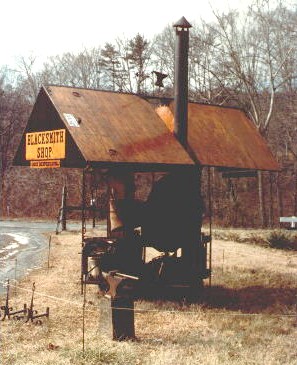
Portable Blacksmith Shop
While sitting at a crafts fair with sore cheeks from smiling all day and saying yes I made that and explaining that you heat the metal up to a yellow heat, I came up with the idea for this portable shop.
I started sketching designs based on a trailer frame. After several unsatifactory ideas I said to myself, lets get completely crazy and divide the box diagonaly! Hmmmm. Intresting, but will it work?
As an artist and a draftsman I am pretty good at visualizing geometrys but this I couldn't make myself believe, would work. I had to build a paper model!
Eventualy the model was used to locate equipment.
The working drawing was sketched three dimensionaly on a sketch pad (see photo of frame) and the whole thing built in a couple months between other work.
This included building the forge and bellows. Total cost in 1977 was $832 US.
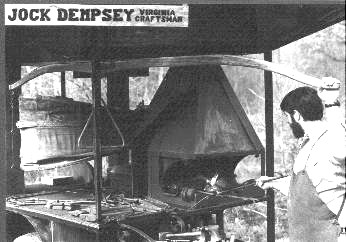 The forge, bellows, slacktub, vise and drill (behind bellows) form a compact unit yet the working space is efficiently arranged.
The bellows handle is close enough to the forge to be one step from the anvil, far enough to be comfortable and out of the way of the vise AND anvil so that a helper can operate the bellows without being in the way.
The roof keeps the equipment dry and provides shelter for the smith and a place to hang signs.
Storage on and under the benchtop is sufficient for several hundred pounds of coal, a couple hundred feet of bar stock and an extensive collection of tools.
The forge, bellows, slacktub, vise and drill (behind bellows) form a compact unit yet the working space is efficiently arranged.
The bellows handle is close enough to the forge to be one step from the anvil, far enough to be comfortable and out of the way of the vise AND anvil so that a helper can operate the bellows without being in the way.
The roof keeps the equipment dry and provides shelter for the smith and a place to hang signs.
Storage on and under the benchtop is sufficient for several hundred pounds of coal, a couple hundred feet of bar stock and an extensive collection of tools.
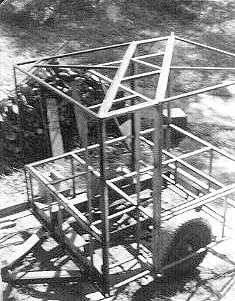 The frame is made of 1-1/4" and 1" structural tubing.
The 1-1/4 making up the support frame.
This size was convienient in that telescoping legs made of 1" square bar slides easily inside.
The leveling legs lock in place with 1/2" setscrews.
The roof frames are made of 1" 0.059 wall tubing.
Covering the roof with plywood was a mistake.
It was heavy and it didn't hold up against coal ash.
The roof was revarnished several times but the varnish rapidly deteriorated and now the roof needs to be replaced.
The axle, springs and wheels are from under an old Chevrolet "ton" truck.
Besides the traditional equipment the shop was also equiped with oxy-actylene equipment for those unexpected jobs.
The frame is made of 1-1/4" and 1" structural tubing.
The 1-1/4 making up the support frame.
This size was convienient in that telescoping legs made of 1" square bar slides easily inside.
The leveling legs lock in place with 1/2" setscrews.
The roof frames are made of 1" 0.059 wall tubing.
Covering the roof with plywood was a mistake.
It was heavy and it didn't hold up against coal ash.
The roof was revarnished several times but the varnish rapidly deteriorated and now the roof needs to be replaced.
The axle, springs and wheels are from under an old Chevrolet "ton" truck.
Besides the traditional equipment the shop was also equiped with oxy-actylene equipment for those unexpected jobs.
This rig was the envy of all the craftsmen at the shows we worked and took the "display" prize at practically every fair.
It only took 10-15 minutes from the time we disconected the hitch until we had a fire in the forge, our fence set up and we were ready for business! With a helper it could be done in 5 minutes!
Not only was this my demonstration shop, it was my home shop as well.
It was used parked in the driveway with an extension cord for a grinder and welding leads from a Miller "buzz box" sitting in the basement.
With the vise anchored to a 4,000 pound "bench" and a hanger for my torch on the front corner of the forge "rack" this was the most convienient work setup I have every had.
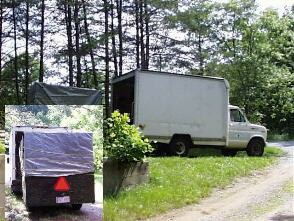 In June of 1998 I sold the portable shop trailer to Historic Bethbara Park of Winston-Salem, NC.
Jim 'paw paw' Wilson, as the Blacksmith for Historic Bethabara Park thought that it might be of exhibit value to the Park.
He showed the above pictures to the Director of the park, and he got excited about the prospect.
In June of 1998 I sold the portable shop trailer to Historic Bethbara Park of Winston-Salem, NC.
Jim 'paw paw' Wilson, as the Blacksmith for Historic Bethabara Park thought that it might be of exhibit value to the Park.
He showed the above pictures to the Director of the park, and he got excited about the prospect.
At the time the shop had been sitting unused for 10 years and the wood covering was rotted and much of the light weight roof framing needed repair.
Selling it to an organization that could afford repairs was the best thing I could have done at the time.
The photo at left is of the trailer leaving home. . . The tarp on the top is to keep pieces from blowing off.
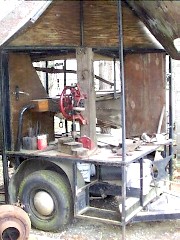
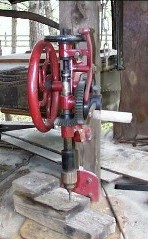
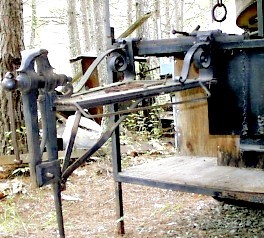 Photos of the "aged" trailer. Note the moss growing on the tires. Seems that they just barely made the 150 mile trip to its new home.
The rectangular space in the front corner was designed for drawers which I never built but have since been installed by Jim Wilson.
Photos of the "aged" trailer. Note the moss growing on the tires. Seems that they just barely made the 150 mile trip to its new home.
The rectangular space in the front corner was designed for drawers which I never built but have since been installed by Jim Wilson.
The Champion drill press was a joy to use. The original table was missing and I used the step block for height adjustment.
The vise was mounted on a triangular "bench" that was hinged to the deck and folded away.
A tong rack was built into the near side. This was the handiest leg vise setup I have ever had and still miss it.
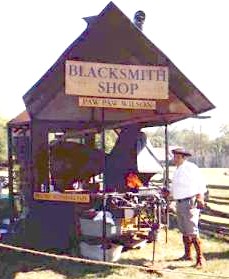 Portable blacksmith shop in its second reincarnation.
Portable blacksmith shop in its second reincarnation.
After Bethbara purchased the trailer in 1998 Jim Wilson replaced the roof and deck as well as repairing the rusted out forge.
There was also much cleaning and repainting. Plus new tires and signs.
Jim also finished items from my design sketches such as the storage drawers and a grill made of horseshoes next to the forge.
Jim has traveled with it to Tennesee, Kentucky and Virginia as well as using it at Bethbara park and other locations in North Carolina.
My portable blacksmith shop in its third reincarnation!
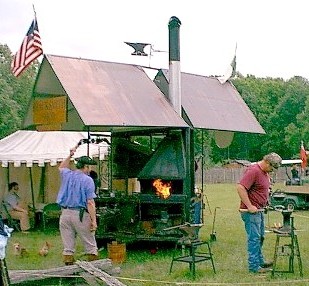
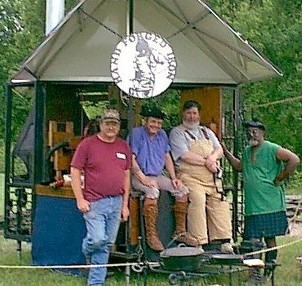
|
Demonstrating at Bethbara park during the Celtic Fest, Jim Wilson at the Bellows, Joe Rotenberry forging and I'm in the tent in the background taking a break.
|
From left to right, Joe Rotenberry, Jim Wilson, myself and Jim Lewis in the Kilt.
May 2002. Photos by Sheri Wilson.
|
In its third reincarnation above the roof has been replaced with copper covered aluminium and aluminum framing and now has a fancy electric mechanism to raise the roof!
Big bucks! However, the "light weight" aluminium frames and covering are actually heavier than the original steel and wood. . .
Replacing the wheels and axels is next. . . There is not going to be much of the original left pretty soon.
After Jim Wilson passed away in 2005 the trailer was used several more times but had fallen into disrepair.
It needed new bellows and air pipe among other bits and pieces. I quoted repairs but nothing came of it. . .
Original design sketches Link to drawings.
Double Chambered Bellows Used in the Portable Shop
Copyright ©1998, 2002, 2013 Jock Dempsey


|
Portable Blacksmith Shop
While sitting at a crafts fair with sore cheeks from smiling all day and saying yes I made that and explaining that you heat the metal up to a yellow heat, I came up with the idea for this portable shop. I started sketching designs based on a trailer frame. After several unsatifactory ideas I said to myself, lets get completely crazy and divide the box diagonaly! Hmmmm. Intresting, but will it work? As an artist and a draftsman I am pretty good at visualizing geometrys but this I couldn't make myself believe, would work. I had to build a paper model! Eventualy the model was used to locate equipment.The working drawing was sketched three dimensionaly on a sketch pad (see photo of frame) and the whole thing built in a couple months between other work. This included building the forge and bellows. Total cost in 1977 was $832 US.
 The forge, bellows, slacktub, vise and drill (behind bellows) form a compact unit yet the working space is efficiently arranged.
The bellows handle is close enough to the forge to be one step from the anvil, far enough to be comfortable and out of the way of the vise AND anvil so that a helper can operate the bellows without being in the way.
The roof keeps the equipment dry and provides shelter for the smith and a place to hang signs.
Storage on and under the benchtop is sufficient for several hundred pounds of coal, a couple hundred feet of bar stock and an extensive collection of tools.
The forge, bellows, slacktub, vise and drill (behind bellows) form a compact unit yet the working space is efficiently arranged.
The bellows handle is close enough to the forge to be one step from the anvil, far enough to be comfortable and out of the way of the vise AND anvil so that a helper can operate the bellows without being in the way.
The roof keeps the equipment dry and provides shelter for the smith and a place to hang signs.
Storage on and under the benchtop is sufficient for several hundred pounds of coal, a couple hundred feet of bar stock and an extensive collection of tools.
 The frame is made of 1-1/4" and 1" structural tubing.
The 1-1/4 making up the support frame.
This size was convienient in that telescoping legs made of 1" square bar slides easily inside.
The leveling legs lock in place with 1/2" setscrews.
The roof frames are made of 1" 0.059 wall tubing.
Covering the roof with plywood was a mistake.
It was heavy and it didn't hold up against coal ash.
The roof was revarnished several times but the varnish rapidly deteriorated and now the roof needs to be replaced.
The axle, springs and wheels are from under an old Chevrolet "ton" truck.
Besides the traditional equipment the shop was also equiped with oxy-actylene equipment for those unexpected jobs.
The frame is made of 1-1/4" and 1" structural tubing.
The 1-1/4 making up the support frame.
This size was convienient in that telescoping legs made of 1" square bar slides easily inside.
The leveling legs lock in place with 1/2" setscrews.
The roof frames are made of 1" 0.059 wall tubing.
Covering the roof with plywood was a mistake.
It was heavy and it didn't hold up against coal ash.
The roof was revarnished several times but the varnish rapidly deteriorated and now the roof needs to be replaced.
The axle, springs and wheels are from under an old Chevrolet "ton" truck.
Besides the traditional equipment the shop was also equiped with oxy-actylene equipment for those unexpected jobs.
This rig was the envy of all the craftsmen at the shows we worked and took the "display" prize at practically every fair. It only took 10-15 minutes from the time we disconected the hitch until we had a fire in the forge, our fence set up and we were ready for business! With a helper it could be done in 5 minutes!
Not only was this my demonstration shop, it was my home shop as well. It was used parked in the driveway with an extension cord for a grinder and welding leads from a Miller "buzz box" sitting in the basement. With the vise anchored to a 4,000 pound "bench" and a hanger for my torch on the front corner of the forge "rack" this was the most convienient work setup I have every had.
At the time the shop had been sitting unused for 10 years and the wood covering was rotted and much of the light weight roof framing needed repair. Selling it to an organization that could afford repairs was the best thing I could have done at the time.
The photo at left is of the trailer leaving home. . . The tarp on the top is to keep pieces from blowing off.
The Champion drill press was a joy to use. The original table was missing and I used the step block for height adjustment.
The vise was mounted on a triangular "bench" that was hinged to the deck and folded away. A tong rack was built into the near side. This was the handiest leg vise setup I have ever had and still miss it.
After Bethbara purchased the trailer in 1998 Jim Wilson replaced the roof and deck as well as repairing the rusted out forge. There was also much cleaning and repainting. Plus new tires and signs. Jim also finished items from my design sketches such as the storage drawers and a grill made of horseshoes next to the forge. Jim has traveled with it to Tennesee, Kentucky and Virginia as well as using it at Bethbara park and other locations in North Carolina.
My portable blacksmith shop in its third reincarnation!
In its third reincarnation above the roof has been replaced with copper covered aluminium and aluminum framing and now has a fancy electric mechanism to raise the roof! Big bucks! However, the "light weight" aluminium frames and covering are actually heavier than the original steel and wood. . .
Replacing the wheels and axels is next. . . There is not going to be much of the original left pretty soon.
After Jim Wilson passed away in 2005 the trailer was used several more times but had fallen into disrepair. It needed new bellows and air pipe among other bits and pieces. I quoted repairs but nothing came of it. . .
Original design sketches Link to drawings.
Double Chambered Bellows Used in the Portable Shop